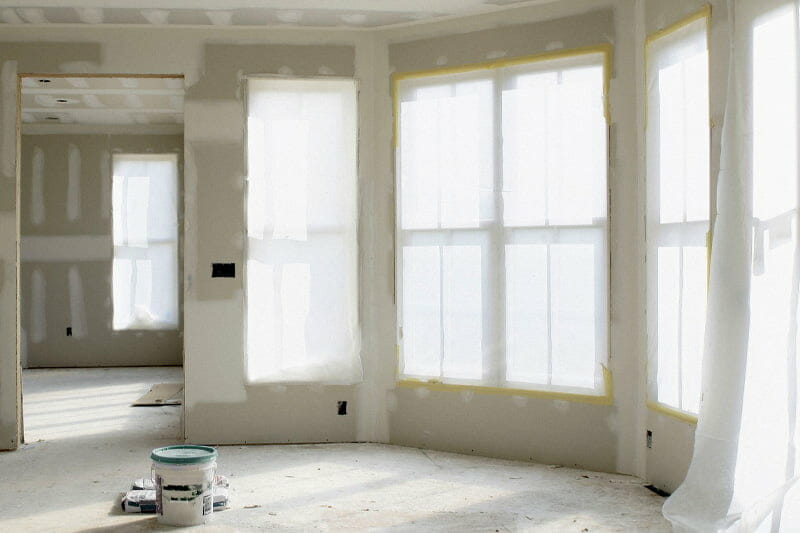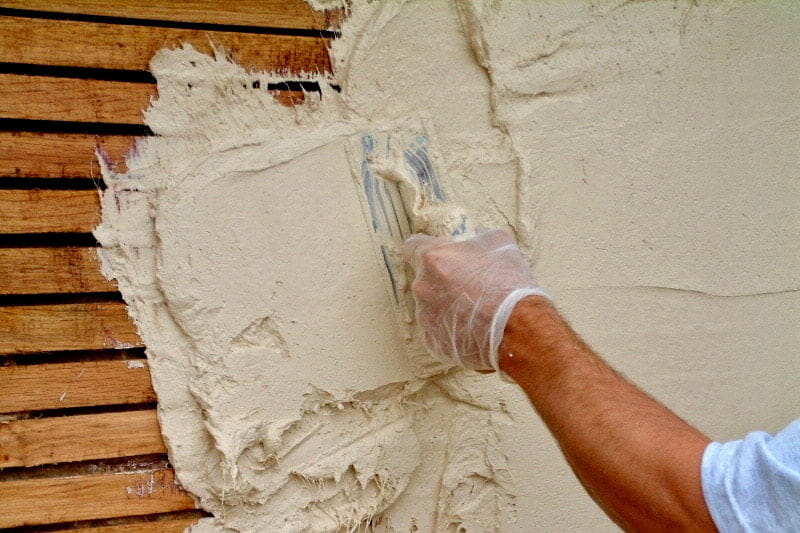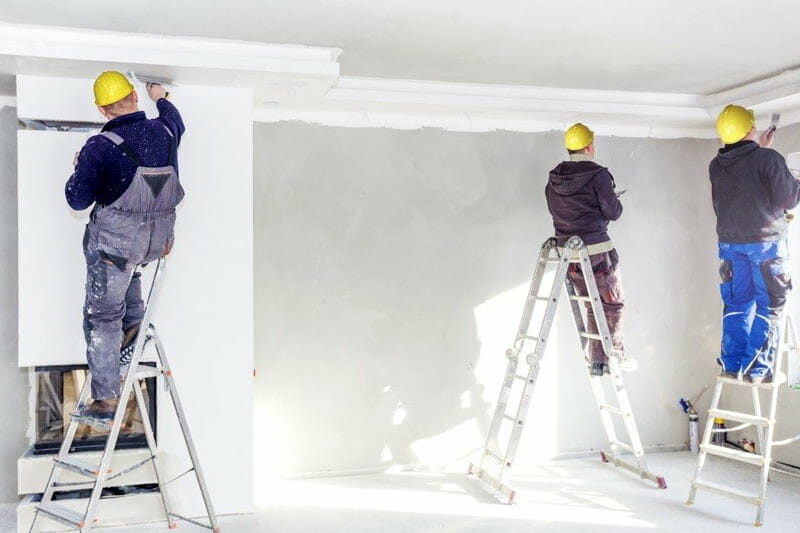For numerous years, drywall has retained its position as a preferred material within the global construction sector. It is widely utilized in various construction endeavors.
Drywall was invented in 1916 by the United States Gypsum Corporation. It is composed of two layers of paperboard with gypsum sandwiched between them.
Let us look more into when drywall became so popular.

History of drywall
In the early 1900s, the United States Gypsum Company invented a product for use as fireproofing tiles.
Another company, The Sackett Plasterboard Company, invented the Sacketboard. It was a panel made of several layers of plaster and paper. USG bought the Sackett Plasterboard Company in 1909.
In 1916, USG introduced to the market Sheetrock. However, it did not catch on as soon as they expected. People thought it was cheap and ugly.
Earlier on, builders used drywall together with plaster. ¼ inch drywall panels became wood lath replacements.
After World War 2, there was an expansion in the construction industry as more homes were needed. To meet the new demand for housing, builders had to build new homes fast and cost-effectively. Drywall made it possible.
From then on, the demand for drywall has been high. Its fireproof qualities have raised its profile and enhanced its demand for builders seeking to meet the building codes.
There are different types of drywall suitable for varying regions. Some are moisture, mildew, and mold resistant. Other types can be used with plaster and are soundproof.
It is lightweight and easy to DIY.
What was used before drywall
Before drywall became a mainstream building material, builders used plaster,
They would build their walls by applying many layers of plaster over a thin strip of wood. The result was a sturdy, smooth and durable wall.
Over the years, drywall manufacturing advancements have made it a popular product. It is easy to paint and can be used to transform a room fast and cheaply. It also developed in strength and ability to handle moisture, mold, fire, and sound.

Types of drywall
Here are the common types of drywall.
Regular drywall
It is white on one side and brown on the other and is often called white drywall. Builders use it on home ceilings and walls. You will also see it in large commercial buildings.
Regular drywall is the most common type of drywall. It is available in four by eight panels and thicknesses ranging from ¼ to ⅜ inches.
Mold resistant drywall
It is also known as the green board. It has a green cover and a wax coating that gives it its name and enhances its moisture handling capabilities. It also consists of fiberglass mesh which makes it mold resistant. However, it is not waterproof.
Install it in areas of the house likely to have moisture, such as bathrooms, kitchens, and laundry rooms. You can also use it as a tile backer. Ensure that it does not come into contact with water.
It is more expensive than regular drywall.
Blue board drywall
It is also known as plasterboard. A super absorbent blue paper covers its surface. The cover allows the plaster to stick faster. Therefore, it is used for veneer plastering or as a base for other plaster applications.
It is both water and mold-resistant. Do not paint it or use mud or paint.
Install it in old houses to create a lath and plaster look. Also, install it in bathrooms and other places with high moisture levels. It is also soundproof. You can install it in areas sensitive to noise.
Paperless drywall
Improvements in drywall manufacturing technology continuously reduce the need for paper-covered drywall. Soon, paperless drywall will become regular drywall.
It is covered with fiberglass and not paper. It enhances its mold and mildew resistance. Additionally, it ensures that the drywall does not rot.
It is sturdier than regular drywall and needs joint compound for a smooth finish. It is also easier to cut and hang.
Purple drywall
It gets its name from the purple paper that covers it. It is similar to regular drywall. However, it has superior moisture and mold resistance. You can install it in rooms with high moisture content. It is also not destroyed by water.
Fire resistant drywall
Many councils and cities require homeowners to install fire-resistant drywall in their basements and garages. It has led to its growth in popularity and use.
There are two types of fire-resistant drywall, Type X and Type C. They are classified based on their ability to slow a fire.
Type X drywall will slow down a fire longer than Type C drywall. A fire will take about 60 and 45 minutes to consume these drywall types.
Install Type X on walls, and you can install it in layers.
Type C is installed in ceilings since it does not shrink as it burns. Thus, it can help maintain the structural integrity of the burning building.
Fire-resistant drywall slows down building fires to provide time for fire services to get to a burning house.
Soundproof drywall
All types of drywall have an element of noise reduction. However, soundproof drywall is thicker than other drywall types enhancing its noise minimization qualities.
It is laminated with fiberglass. It has more wood fiber, gypsum, and polymers to increase its sound transmission class over other drywall types.
Since it is denser, it is difficult to cut and hang. Install it in rooms that need silence or between walls to reduce noise transmission.
VOC-absorbing drywall
VOC-absorbing drywall traps volatile organic compounds(VOC) and other chemicals from the air. It absorbs them and traps them in the gypsum.
Install it on walls and ceilings. Additionally, it is durable and lasts for about 75 years.
Benefits of drywall
Cost effective
There are many types of drywall. Each type of drywall has its price. You can choose the drywall type suitable for your project.
Additionally, drywall is easy to DIY. Thus, it reduces the labor and installation costs when you don’t have to hire professionals to do it for you.
Safety
The safest drywall type is fire-resistant drywall. Fire-resistant drywall reduces the spread of fire in your home. It provides enough time to get to safety or put off the fire before it harms you or destroys property.
Mold-resistant drywall prevents the growth of mold on moist walls. Thus, it protects you from mold-caused diseases and your property.
Easy to repair
Drywall is easy to repair. The materials and the process of repair are locally available.
When the drywall is damaged, you will not need to replace the whole panel or wall. You only need to fix the part that is damaged. Most times, you will not need to hire a professional for repair.
Finishing options
When you install drywall on your walls, you can finish your walls in many ways.
First, you can paint on drywall. Prepare your drywall for painting. You can paint drywall with different colors and different types of paint.
Second, you can finish your walls with wallpaper. It is easy to cover drywall with wallpaper.
Additionally, you can affix tiles on drywall. You can do it in the kitchen, bathroom, and areas with lots of water and moisture. Ensure to use moisture-resistant and mold-resistant drywall.
Insulation properties
Drywall helps to enhance the insulation of a room. It ensures that it maintains its temperature. Thus, improving the comfortability of the room.
Disadvantages of drywall
- While you can DIY drywall installation, you must be a pro or trained to do it properly.
- You cannot install drywall on its own. It needs a wall.
- You cannot install electrical insulation on drywall. It must be between two layers of drywall.
- You cannot use it for external walls.

Hire a Pro to install drywall
Homegardenguides.com is a free tool to hire professional drywall installation service providers.
It connects homeowners to professionals in the following easy steps.
- Enter your zip code at the top of the tool.
- Fill in the form to provide more details about the drywall service you need.
- You will receive three or four quotes and advice from professional drywall installers.
- Contact and hire a service that falls within your budget.








